Abstract
The Africanized honeybee, popularly known as the "killer bee," is already well established in Texas and has recently entered California and Arizona. As the Africanized honeybee spreads in North America, the medical community must become aware of the problems associated with this insect and ensure that sting emergencies can be handled quickly and appropriately. The major differences between Africanized and European honeybees are that the former are more irritable, they swarm more readily and frequently, they defend their hives more vehemently, and they sting more collectively. It is not the composition nor the volume of an individual bee's venom, but rather the cumulative dose of multiple stings that accounts for the morbidity and mortality associated with Africanized honeybee-sting incidents. Even nonallergic persons are susceptible to the toxic effects of these large combined venom loads. Africanized honeybee-sting victims are treated the same as victims of European honeybee stings. Authorities will prepare for the bees' arrival by expanding public awareness, teaching risk-avoidance behavior, providing for the removal of troublesome hives, and developing sting treatment protocols that can be initiated rapidly in the field or emergency departments. Health care professionals should participate in the educational efforts and in the development of needed emergency response protocols so that the effects of the Africanized honeybee will be merely a nuisance rather than a plague.
Full text
PDF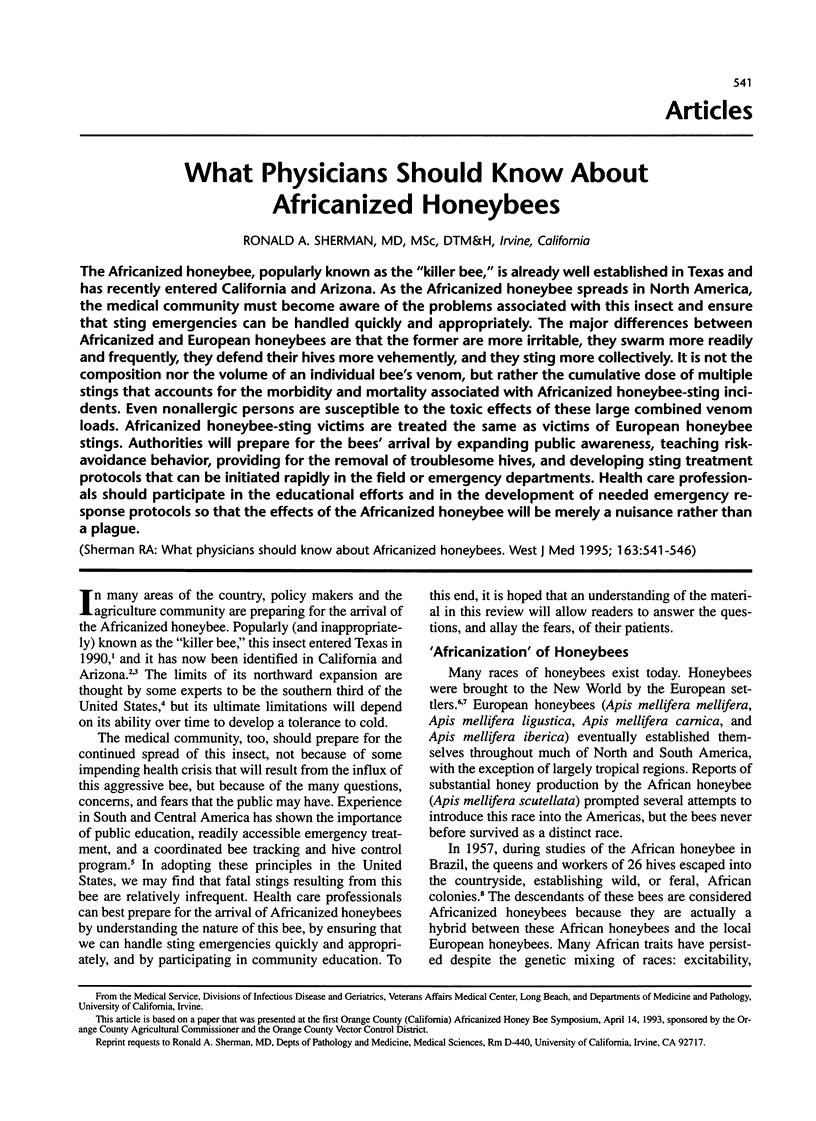
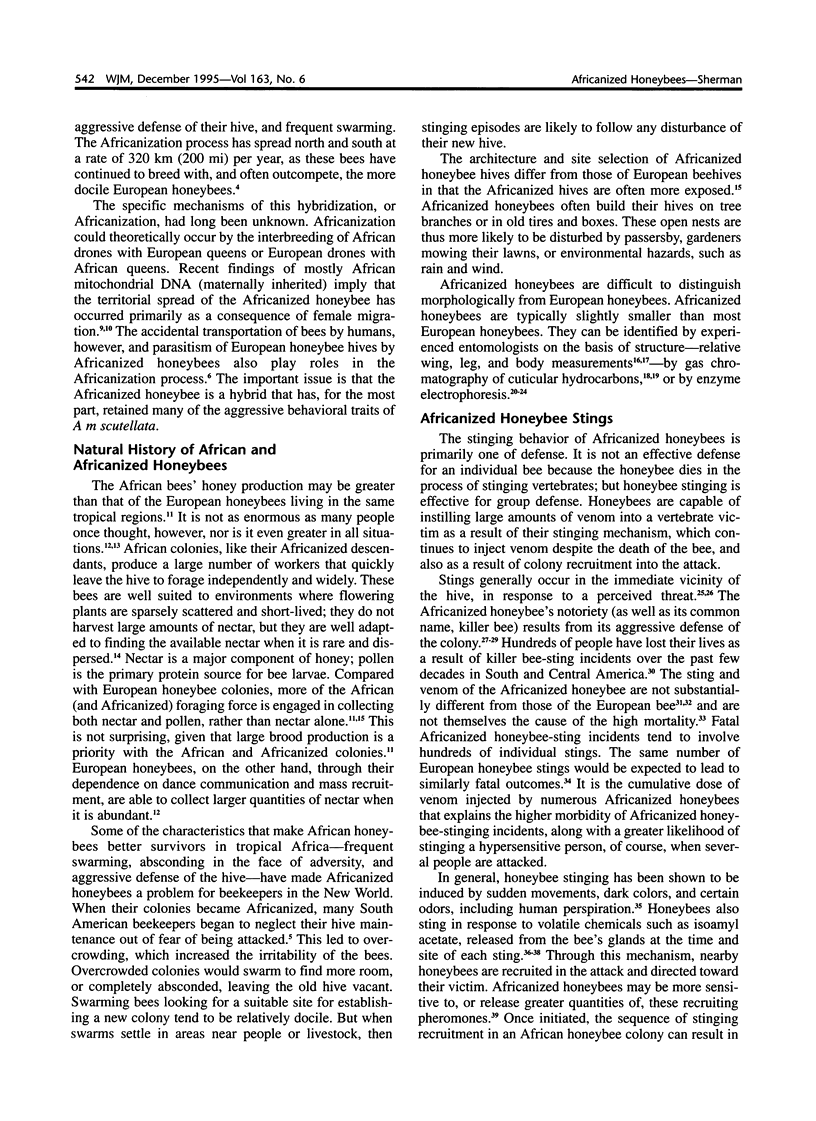
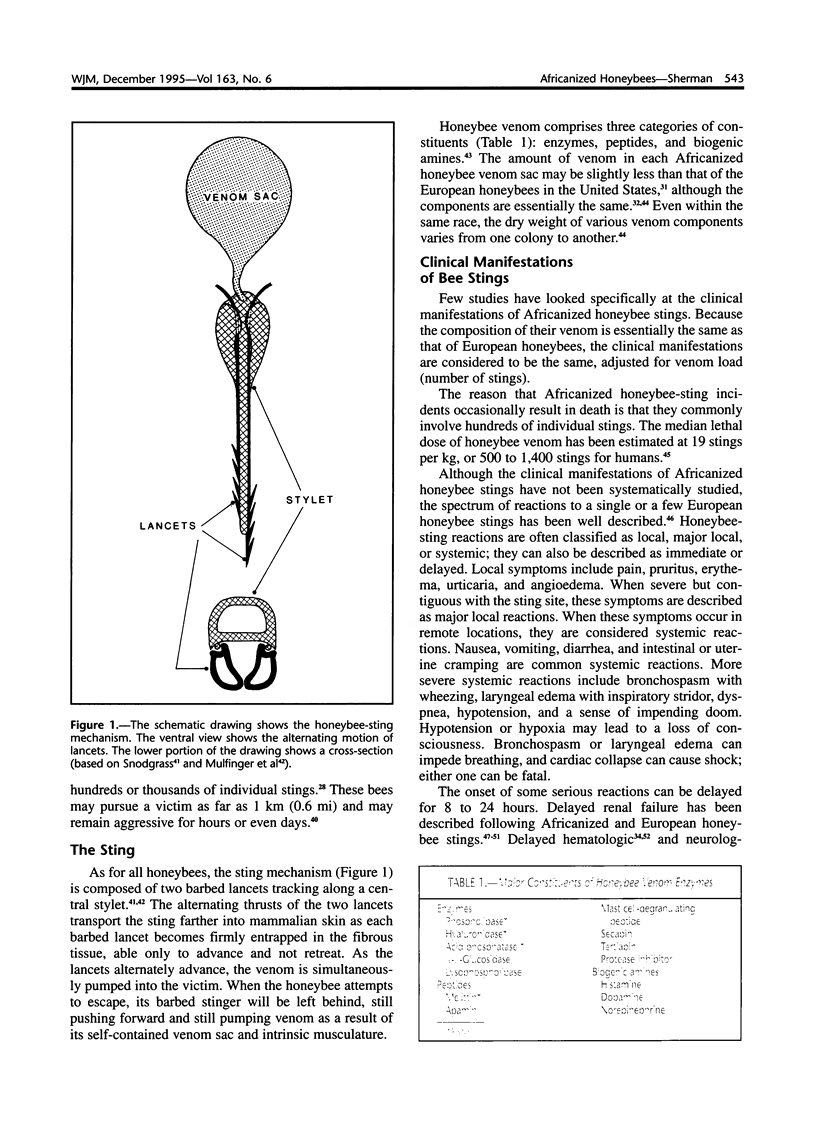
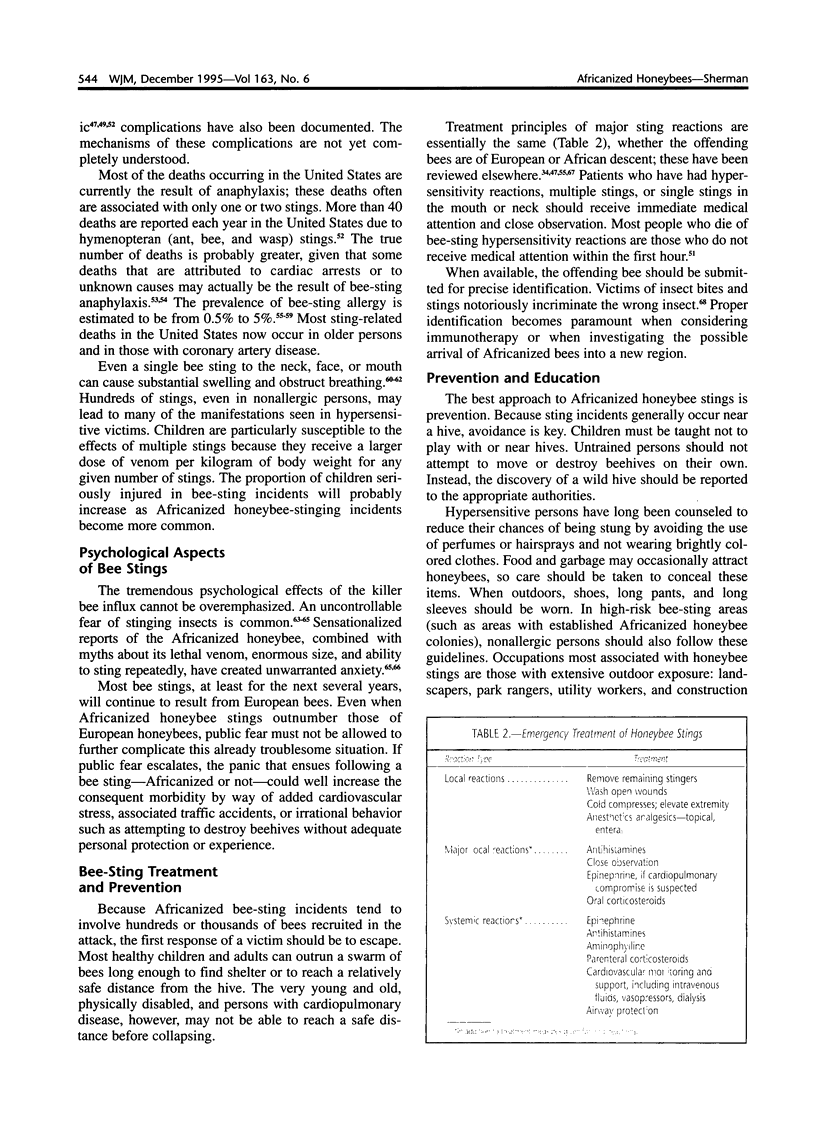
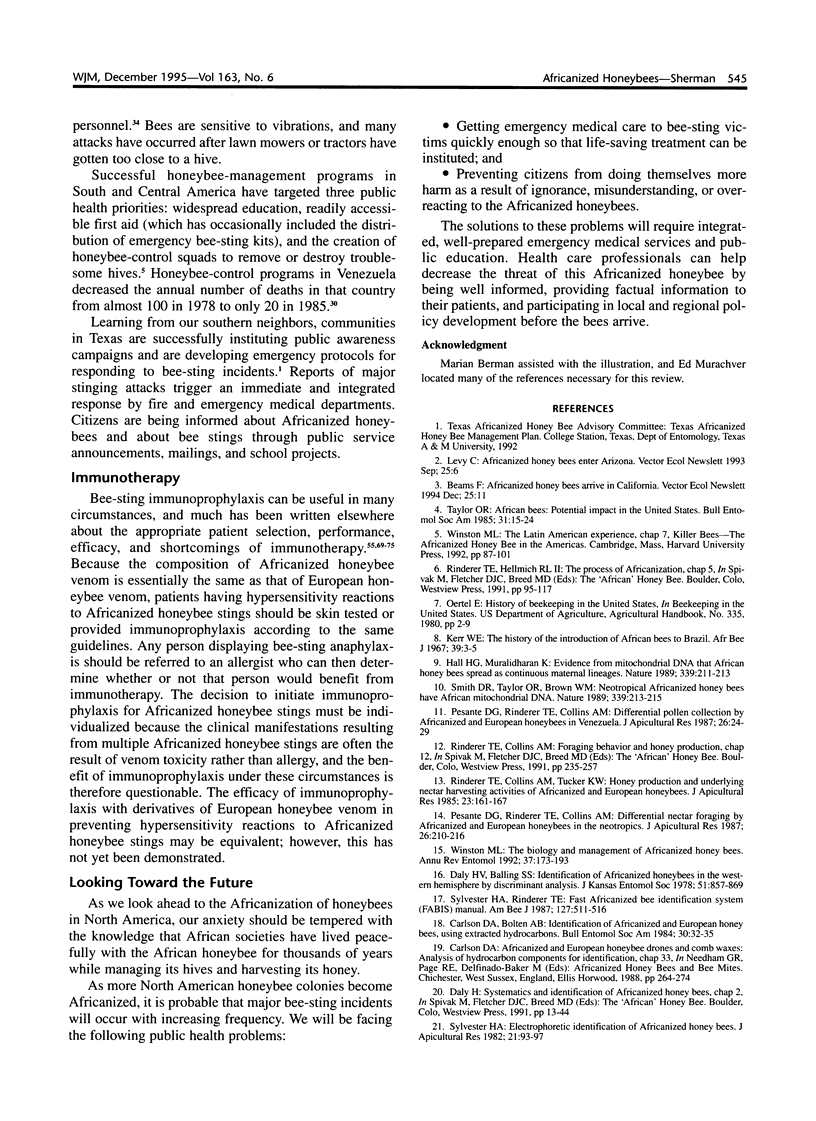
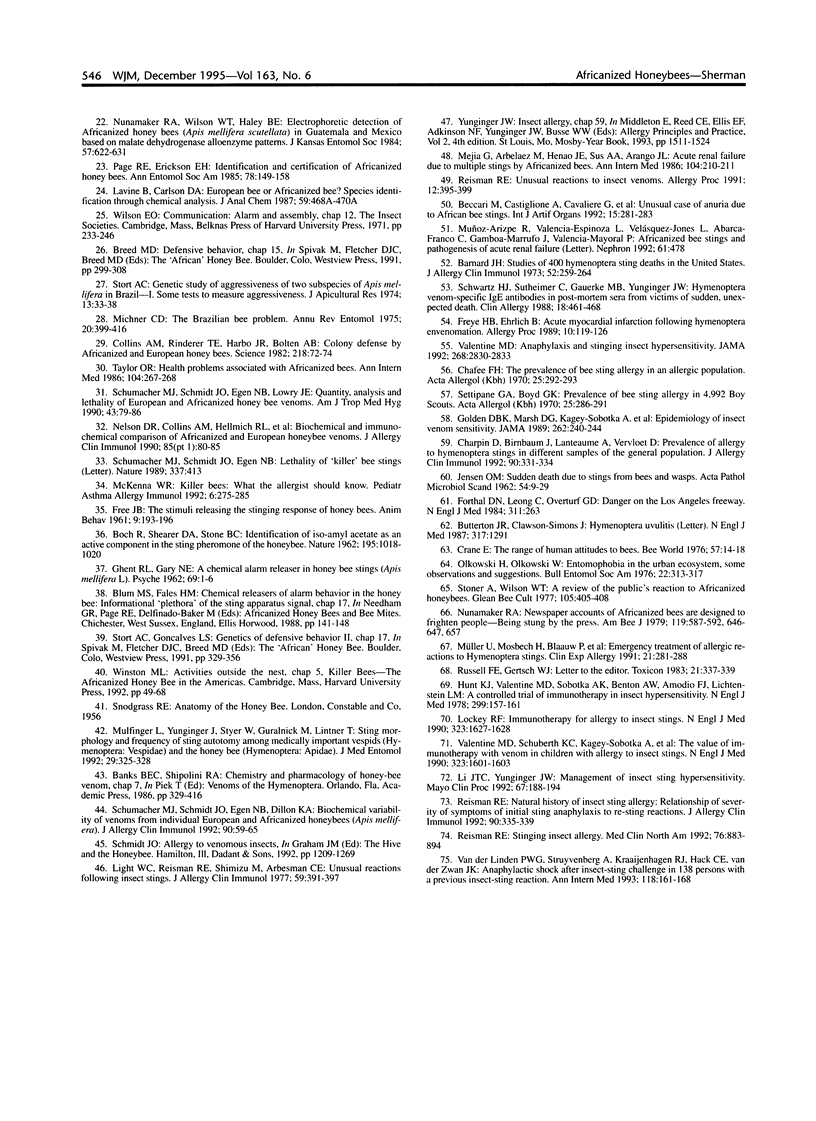
Selected References
These references are in PubMed. This may not be the complete list of references from this article.
- BOCH R., SHEARER D. A., STONE B. C. Identification of isoamyl acetate as an active component in the sting pheromone of the honey bee. Nature. 1962 Sep 8;195:1018–1020. doi: 10.1038/1951018b0. [DOI] [PubMed] [Google Scholar]
- Barnard J. H. Studies of 400 Hymenoptera sting deaths in the United States. J Allergy Clin Immunol. 1973 Nov;52(5):259–264. doi: 10.1016/0091-6749(73)90044-4. [DOI] [PubMed] [Google Scholar]
- Beccari M., Castiglione A., Cavaliere G., d'Aloya G., Fabbri C., Losi B., Ranzini C., Romagnoni G., Sorgato G. Unusual case of anuria due to African bee stings. Int J Artif Organs. 1992 May;15(5):281–283. [PubMed] [Google Scholar]
- Butterton J. R., Clawson-Simons J. Hymenoptera uvulitis. N Engl J Med. 1987 Nov 12;317(20):1291–1291. doi: 10.1056/NEJM198711123172013. [DOI] [PubMed] [Google Scholar]
- Chafee F. H. The prevalence of bee sting allergy in an allergic population. Acta Allergol. 1970 Aug;25(4):292–293. doi: 10.1111/j.1398-9995.1970.tb01265.x. [DOI] [PubMed] [Google Scholar]
- Charpin D., Birnbaum J., Lanteaume A., Vervloet D. Prevalence of allergy to hymenoptera stings in different samples of the general population. J Allergy Clin Immunol. 1992 Sep;90(3 Pt 1):331–334. doi: 10.1016/s0091-6749(05)80011-9. [DOI] [PubMed] [Google Scholar]
- Collins A. M., Rinderer T. E., Harbo J. R., Bolten A. B. Colony defense by africanized and European honey bees. Science. 1982 Oct 1;218(4567):72–74. doi: 10.1126/science.218.4567.72. [DOI] [PubMed] [Google Scholar]
- Crane G. W. Distractions. We have to keep our attention on primary issues--especially in '76. CAL. 1976 May;39(11):14-5, 18-9. [PubMed] [Google Scholar]
- Forthal D. N., Leong C., Overturf G. D. Danger on the Los Angeles freeway. N Engl J Med. 1984 Jul 26;311(4):263–263. doi: 10.1056/NEJM198407263110424. [DOI] [PubMed] [Google Scholar]
- Freye H. B., Ehrlich B. Acute myocardial infarction following hymenoptera envenomation. Allergy Proc. 1989 Mar-Apr;10(2):119–126. doi: 10.2500/108854189778961035. [DOI] [PubMed] [Google Scholar]
- Golden D. B., Marsh D. G., Kagey-Sobotka A., Freidhoff L., Szklo M., Valentine M. D., Lichtenstein L. M. Epidemiology of insect venom sensitivity. JAMA. 1989 Jul 14;262(2):240–244. [PubMed] [Google Scholar]
- Hall H. G., Muralidharan K. Evidence from mitochondrial DNA that African honey bees spread as continuous maternal lineages. Nature. 1989 May 18;339(6221):211–213. doi: 10.1038/339211a0. [DOI] [PubMed] [Google Scholar]
- Hunt K. J., Valentine M. D., Sobotka A. K., Benton A. W., Amodio F. J., Lichtenstein L. M. A controlled trial of immunotherapy in insect hypersensitivity. N Engl J Med. 1978 Jul 27;299(4):157–161. doi: 10.1056/NEJM197807272990401. [DOI] [PubMed] [Google Scholar]
- JENSEN O. M. Sudden death due to stings from bees and wasps. Report on four new cases, three with autopsy. Acta Pathol Microbiol Scand. 1962;54:9–29. doi: 10.1111/j.1699-0463.1962.tb01218.x. [DOI] [PubMed] [Google Scholar]
- Li J. T., Yunginger J. W. Management of insect sting hypersensitivity. Mayo Clin Proc. 1992 Feb;67(2):188–194. doi: 10.1016/s0025-6196(12)61321-4. [DOI] [PubMed] [Google Scholar]
- Light W. C., Reisman R. E., Shimizu M., Arbesman C. E. Unusual reactions following insect stings. Clinical features and immunologic analysis. J Allergy Clin Immunol. 1977 May;59(5):391–397. doi: 10.1016/0091-6749(77)90024-0. [DOI] [PubMed] [Google Scholar]
- Lockey R. F. Immunotherapy for allergy to insect stings. N Engl J Med. 1990 Dec 6;323(23):1627–1628. doi: 10.1056/NEJM199012063232310. [DOI] [PubMed] [Google Scholar]
- Mejia G., Arbelaez M., Henao J. E., Sus A. A., Arango J. L. Acute renal failure due to multiple stings by Africanized bees. Ann Intern Med. 1986 Feb;104(2):210–211. doi: 10.7326/0003-4819-104-2-210. [DOI] [PubMed] [Google Scholar]
- Michener C. D. The Brazilian bee problem. Annu Rev Entomol. 1975;20:399–416. doi: 10.1146/annurev.en.20.010175.002151. [DOI] [PubMed] [Google Scholar]
- Mulfinger L., Yunginger J., Styer W., Guralnick M., Lintner T. Sting morphology and frequency of sting autotomy among medically important vespids (Hymenoptera: Vespidae) and the honey bee (Hymenoptera: Apidae). J Med Entomol. 1992 Mar;29(2):325–328. doi: 10.1093/jmedent/29.2.325. [DOI] [PubMed] [Google Scholar]
- Muñoz-Arizpe R., Valencia-Espinoza L., Velásquez-Jones L., Abarca-Franco C., Gamboa-Marrufo J., Valencia-Mayoral P. Africanized bee stings and pathogenesis of acute renal failure. Nephron. 1992;61(4):478–478. doi: 10.1159/000186975. [DOI] [PubMed] [Google Scholar]
- Müller U., Mosbech H., Blaauw P., Dreborg S., Malling H. J., Przybilla B., Urbanek R., Pastorello E., Blanca M., Bousquet J. Emergency treatment of allergic reactions to Hymenoptera stings. Clin Exp Allergy. 1991 May;21(3):281–288. doi: 10.1111/j.1365-2222.1991.tb01659.x. [DOI] [PubMed] [Google Scholar]
- Nelson D. R., Collins A. M., Hellmich R. L., Jones R. T., Helm R. M., Squillace D. L., Yunginger J. W. Biochemical and immunochemical comparison of Africanized and European honeybee venoms. J Allergy Clin Immunol. 1990 Jan;85(1 Pt 1):80–85. doi: 10.1016/0091-6749(90)90225-s. [DOI] [PubMed] [Google Scholar]
- Reisman R. E. Natural history of insect sting allergy: relationship of severity of symptoms of initial sting anaphylaxis to re-sting reactions. J Allergy Clin Immunol. 1992 Sep;90(3 Pt 1):335–339. doi: 10.1016/s0091-6749(05)80012-0. [DOI] [PubMed] [Google Scholar]
- Reisman R. E. Stinging insect allergy. Med Clin North Am. 1992 Jul;76(4):883–894. doi: 10.1016/s0025-7125(16)30330-3. [DOI] [PubMed] [Google Scholar]
- Reisman R. E. Unusual reactions to insect venoms. Allergy Proc. 1991 Nov-Dec;12(6):395–399. doi: 10.2500/108854191779114239. [DOI] [PubMed] [Google Scholar]
- Russell F. E., Gertsch W. J. For those who treat spider or suspected spider bites. Toxicon. 1983;21(3):337–339. doi: 10.1016/0041-0101(83)90089-2. [DOI] [PubMed] [Google Scholar]
- Schumacher M. J., Schmidt J. O., Egen N. B., Dillon K. A. Biochemical variability of venoms from individual European and Africanized honeybees (Apis mellifera). J Allergy Clin Immunol. 1992 Jul;90(1):59–65. doi: 10.1016/s0091-6749(06)80011-4. [DOI] [PubMed] [Google Scholar]
- Schumacher M. J., Schmidt J. O., Egen N. B. Lethality of 'killer' bee stings. Nature. 1989 Feb 2;337(6206):413–413. doi: 10.1038/337413a0. [DOI] [PubMed] [Google Scholar]
- Schumacher M. J., Schmidt J. O., Egen N. B., Lowry J. E. Quantity, analysis, and lethality of European and Africanized honey bee venoms. Am J Trop Med Hyg. 1990 Jul;43(1):79–86. doi: 10.4269/ajtmh.1990.43.79. [DOI] [PubMed] [Google Scholar]
- Schwartz H. J., Sutheimer C., Gauerke M. B., Yunginger J. W. Hymenoptera venom-specific IgE antibodies in post-mortem sera from victims of sudden, unexpected death. Clin Allergy. 1988 Sep;18(5):461–468. doi: 10.1111/j.1365-2222.1988.tb02896.x. [DOI] [PubMed] [Google Scholar]
- Settipane G. A., Boyd G. K. Prevalence of bee sting allergy in 4,992 boy scouts. Acta Allergol. 1970 Aug;25(4):286–291. doi: 10.1111/j.1398-9995.1970.tb01264.x. [DOI] [PubMed] [Google Scholar]
- Smith D. R., Taylor O. R., Brown W. M. Neotropical Africanized honey bees have African mitochondrial DNA. Nature. 1989 May 18;339(6221):213–215. doi: 10.1038/339213a0. [DOI] [PubMed] [Google Scholar]
- Taylor O. R., Jr Health problems associated with African bees. Ann Intern Med. 1986 Feb;104(2):267–268. doi: 10.7326/0003-4819-104-2-267. [DOI] [PubMed] [Google Scholar]
- Valentine M. D. Anaphylaxis and stinging insect hypersensitivity. JAMA. 1992 Nov 25;268(20):2830–2833. [PubMed] [Google Scholar]
- Valentine M. D., Schuberth K. C., Kagey-Sobotka A., Graft D. F., Kwiterovich K. A., Szklo M., Lichtenstein L. M. The value of immunotherapy with venom in children with allergy to insect stings. N Engl J Med. 1990 Dec 6;323(23):1601–1603. doi: 10.1056/NEJM199012063232305. [DOI] [PubMed] [Google Scholar]
- van der Linden P. W., Struyvenberg A., Kraaijenhagen R. J., Hack C. E., van der Zwan J. K. Anaphylactic shock after insect-sting challenge in 138 persons with a previous insect-sting reaction. Ann Intern Med. 1993 Feb 1;118(3):161–168. doi: 10.7326/0003-4819-118-3-199302010-00001. [DOI] [PubMed] [Google Scholar]


